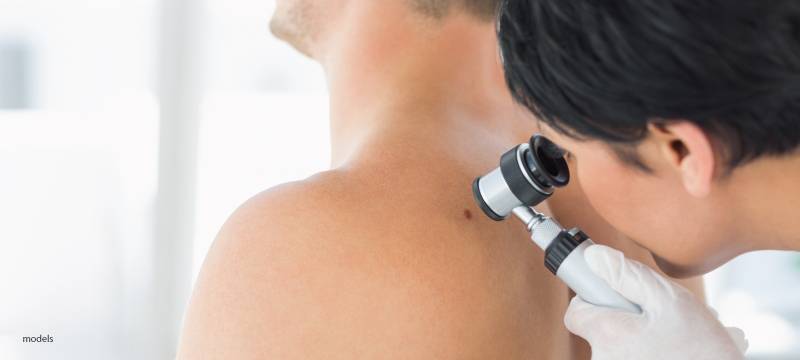Surgical Vs. Non-Surgical Skin Cancer Treatments

Regular skin checks are important for the early detection of skin cancer. An annual skin exam will enable your dermatologist to biopsy suspicious lesions before they grow larger and potentially become more dangerous. When skin cancer is detected early, patients generally have more treatment options. For low grade skin cancer both surgical and non-surgical treatment methods may be available.
Surgical Skin Cancer Removal
Surgical skin cancer removal involves cutting away the cancerous cells. If the entire tumor is removed with clear margins, then typically no other further treatment will be necessary.
Mohs Surgery
Mohs surgery is named after Dr. Frederick Mohs, who started the technique in the 1930’s (the technique became mainstream in the 1980s). This method preserves as much healthy skin as possible to minimize scarring by evaluating the margins while the patient is in the office.
If cancer is still present, a slightly wider margin of tissue is removed. The process is repeated until no cancer is found in the cells bordering the excision. Mohs is performed under local anesthesia, requires a relatively quick and simple recovery, and features a very good cure rate.
Excision
An excision removes the cancerous cells plus a margin of surrounding tissue, to ensure all cancerous cells are removed. The excision is performed with a scalpel under local anesthesia.
Some types of cancer, especially those that are fast-growing, require a wider excision. The technique is the same, but a wider margin of tissue is removed.
Shave Excision
In a shave excision, a thin blade is used to shave the lesion or growth off the skin’s surface. A shave excision is performed under local anesthesia.
Electrodessication & Curettage
Curettage is a method that employs a curette. This long and thin surgical tool has a small sharp scoop on one end. After the cancerous tissue is scooped away, the area is treated with an electric current to stop the bleeding. This process is called electrodessication.
Pros and Cons of Surgical Skin Cancer Treatment
Surgical skin cancer removal is typically the most effective option to ensure complete clearance of the skin cancer.
The side effects of surgery may include pain, scarring or nerve damage. Surgery also introduces the risk of infection.
Non-Surgical Skin Cancer Treatment Options
Otherwise known as local treatments, non-surgical treatment options for skin cancer differ from surgical methods because they do not use scalpels nor require an incision in the skin.
Cryosurgery
Cryosurgery, or cryotherapy, kills cancer cells by freezing them with liquid nitrogen. The process may need to be repeated several times, which can often be done in just one office visit. After treatment, the area blisters and crusts over, eventually healing. This technique is primarily used for “precancers”.
Cryosurgery may leave a small scar or permanent discoloration/white spot.
Photodynamic Therapy (PDT)
Photodynamic therapy begins with the application of a gel that makes cancer cells sensitive to light. Several hours later, the cancerous skin cells are then treated with a special light which kills the cancer.
PDT may cause redness and swelling. Because it makes skin sensitive to sun, even after treatment, protecting yourself from sun exposure is recommended.
This method is most effective for superficial skin cancers or precancerous conditions.
Topical Therapy
Topical immunotherapy or chemotherapy, such as Imiquimod or 5-fluorouracil (5-FU) can be applied topically to skin cancer for several weeks. They attack cancerous cells on the skin’s surface, but won’t reach those deep under the skin. Because of this, the method is most effective for superficial skin cancers or precancerous conditions.
Because it doesn’t spread through the body like systemic chemotherapy does, side effects are minimized.
Superficial Radiation
Radiation therapy is an alternative to surgery and may be used in cases where tumors are very large or would be difficult to remove surgically. Also, radiation is used as an adjunct to surgery in some cases.
Pros and Cons of Non-Surgical Skin Cancer Treatment
Non-surgical treatment options are sometimes used in combination with surgery, especially for aggressive types of skin cancer such as melanoma. They are not an option for every type of skin cancer.
Some non-surgical options are new and their effectiveness is still under review. The best treatment for you will depend on your specific diagnosis, and should be decided in consultation with a trusted and skilled board-certified dermatologist.
Disclaimer: The contents of the Westlake Dermatology website, including text, graphics, and images, are for informational purposes only and are not intended to substitute for direct medical advice from your physician or other qualified professional.
